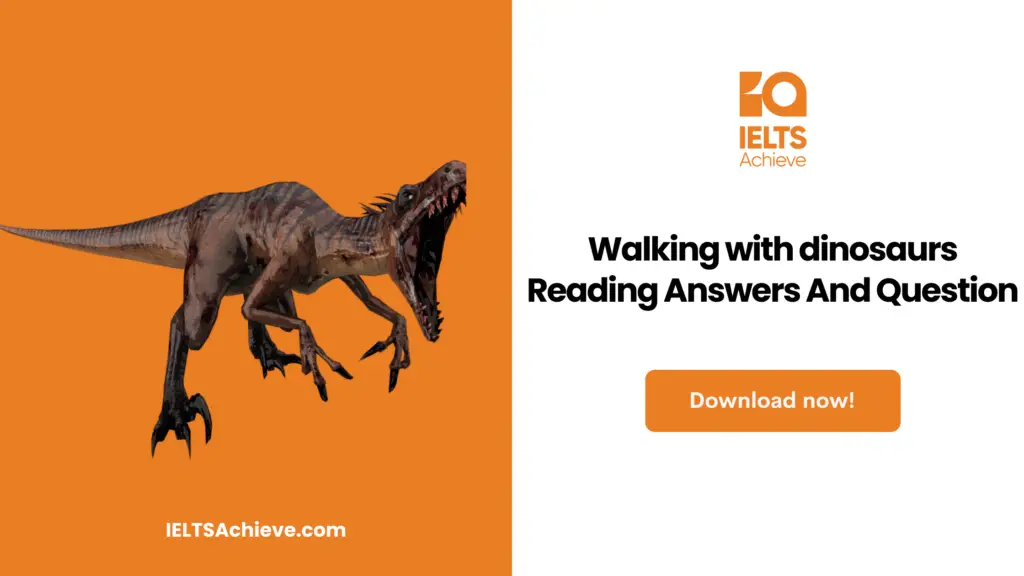The Blog post contains the following IELTS Reading Questions:
- IELTS Reading Yes, No, Not Given
- IELTS Reading Diagram Labelling
- IELTS Reading Flow Chart Completion
Stay informed and prepared for success – Explore our comprehensive Reading Test Info page to get valuable insights, exam format details, and expert tips for mastering the IELTS Reading section.
IELTS Reading Passage: Walking With Dinosaurs

Walking With Dinosaurs
The media occasionally portrays paleontologists or those who research prehistoric life, as meticulously clearing stones from around a large dinosaur bone while they camp in the desert. Peter Falkingham hasn’t exactly been doing that lately, which is the problem. Instead, he stares at a screen nonstop throughout the day. Not because he’s busy, but rather because he works in the relatively new field of computational paleontology. Few people may be aware that when a skeleton or new species is discovered, research truly begins. What we really want to understand is how extinct animals and plants behaved in their natural habitats. Drs. Bill Sellers and Phil Manning of the University of Manchester employ a “genetic algorithm” to analyze the movements and stalking patterns of prehistoric creatures like dinosaurs and our ancestors. A sort of computer code known as a genetic algorithm has the ability to “evolve” and update itself.
The surviving bones of a complete dinosaur skeleton may teach scientists a great deal about the animal, but they do not offer the full image, which a computer can attempt to complete. A scanned skeleton and known muscle locations are provided to the computer model. The model then randomly activates the muscles. This, somewhat unexpectedly, ends in the animal falling on its face almost often. Therefore, the computer modifies the activation sequence and tries again… typically with the same outcome. The modeling dinosaurs rapidly “evolve.” If an improvement is detected, the computer discards the previous pattern and utilizes the new one as the basis for future modifications.
The muscle activation pattern finally develops into a stable mode of locomotion, the optimal solution is reached, and the dinosaur is able to walk, run, chase, and graze. Assuming that natural selection also generates the optimal solution, the modeled species should exhibit comparable behavior to its extinct relative. Moreover, using the same method applied to actual animals (humans, emus, and ostriches), peak computer speeds were comparable to those attained in reality. By comparing their virtual results to actual measurements of current species, the Manchester team of paleontologists may have confidence in the calculated data representing how extinct prehistoric animals, such as dinosaurs, traveled.
The group from Manchester University has modeled a huge carnivorous dinosaur using computer simulations. The spines that run over its back give rise to its common name, “high-spined lizard,” or “acrocanthosaurus.” It is theorized by scientists that they propped up a hump that accumulated fat and water reserves, although this is purely conjectural. Many people also think that a sail was supported by the spines. One group thinks it was a blood-flushable display, while another other thinks it was a thermostat. Perhaps both factors were involved. The narrow breadth and frail jaws of the cranium make it look disproportionate to the massive weight of the body. The feet are especially remarkable because of how little they are in proportion to the rest of the animal. Its large, broad tail and powerful leg muscles allow it to move swiftly and are used to aid in locomotion. It walked on its rear legs, while its front legs were small and equipped with vicious claws.
Falkingham is analyzing historical footprints with modeling tools to learn more about the migratory patterns of extinct animals. Today’s trackers, who research the habitats of wild animals, are able to determine the kind of animal that left behind a set of footprints, as well as the animal’s speed and, in some cases, gender. However, applying the same logic to a fossil trail is far more challenging. Knowing the circumstances under which the path was formed, particularly with regard to the mud or silt that the animal walked on, may be very helpful. These issues can be answered via experiments, however, there are a staggering amount of potential impacts. Physically recreating each incident with a box of mud is a tedious and error-prone procedure. Simulators on computers can help in this endeavor.
Falkingham mimics prehistoric mud by simulating a volume of mud and manipulating the moisture level, consistency, and other variables. The virtual mud is then marked with a virtual foot. Inside this footprint, which can be separated and studied from any angle, the stress values may be retrieved and calculated. By running hundreds of these simulations concurrently on supercomputers, Falkingham may be able to begin to understand what sorts of imprints may be expected if an animal walked in a given way over a specific type of ground. Scientists may more securely interpret fossil tracks with the assistance of the diversity in the recreated trails. Computational approaches in paleontology are becoming more popular by the year. As computer power increases, so will the number of problems that can be addressed and questions that can be answered.
Unlock your full potential in the IELTS Reading section – Visit our IELTS Reading Practice Question Answer page now!
Recommended Questions:
Renewable Energy IELTS Reading Question with Answer
Walking With Dinosaurs IELTS Reading Questions
Question 1-6
Do the following statements agree with the information given in Reading Passage? In boxes 1-6 on your answer sheet, write
YES if the statement agrees with the information
NO if the statement contradicts the information
NOT GIVEN if there is no information on this
- Peter Falkingham does very little fieldwork related to his studies of the ancient era at this point.
- Sellers’ and Manning’s computerized dinosaur model often requires many tries before it can stand on its hind legs.
- When applied to persons, the Sellers and Manning computer model represented them moving faster than their bodies could.
- Concerns have been raised by a few paleontologists regarding the Manchester team’s findings on dinosaur mobility.
- A skilled tracker can identify fossilized animal tracks just as readily as those left by living creatures.
- It has been discovered that the studies done on the composition of ancient mud were wrong.
Want to excel in identifying the writer’s views and claims? Click here to explore our in-depth guide on how to accurately determine Yes, No, or Not Given in the IELTS Reading section.
Questions 7-9
Label the diagram below.

Choose NO MORE THAN ONE WORD from the passage for each answer.
Write youranswers in boxes 7-9 on your answer sheet.
Ready to tackle Diagram Label Completion tasks with confidence? Click here to access our comprehensive guide and learn how to accurately label parts or components of diagrams in the IELTS Reading section.
Questions 10-13
Complete the flowchart below. Write NO MORE THAN TWO WORDS for each answer.
| Mud is stimulated by paying attention to its texture, thickness, and 10. ______ content. |
| A virtual foot leaves a muddy imprint. |
| 11. ______ levels are detected in the footprint. |
| Numerous models link footprints to various 12. ______ types. |
| It is possible to read 13. ______ more accurately. |
Boost your performance in Summary, Notes, Table, and Flowchart Completion tasks. Click here to explore our detailed guide and learn how to effectively complete summaries, notes, tables, and flowcharts in the IELTS Reading section.
Unlock your full potential in the IELTS Reading section – Visit our IELTS Reading Practice Question Answer page now!
Recommended Questions:
Renewable Energy IELTS Reading Question with Answer
Walking With Dinosaurs Reading Answers
1. True
2. True
3. False
4. Not Given
5. True
6. Not Given
7. Sail
8. Narrow
9. Locomotion
10. Moisture
11. Stress
12. Ground
13. Fossil tracks

We hope you found this post useful in helping you to study for the IELTS Test. If you have any questions please let us know in the comments below or on the Facebook page.
The best way to keep up to date with posts like this is to like us on Facebook, then follow us on Instagram and Pinterest. If you need help preparing for the IELTS Test, join the IELTS Achieve Academy and see how we can assist you to achieve your desired band score. We offer an essay correction service, mock exams and online courses.

